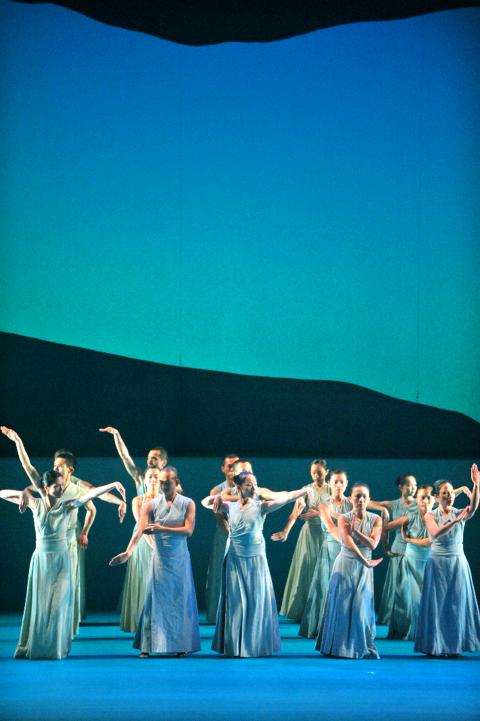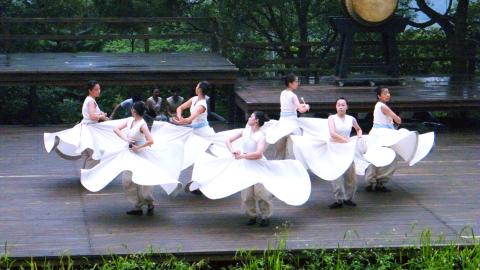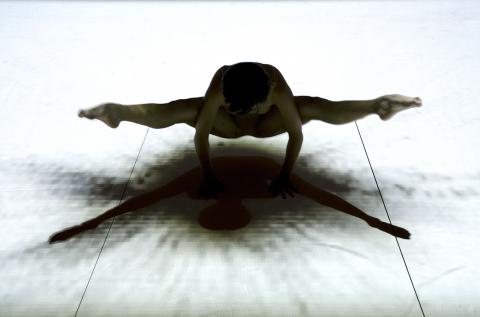Taipei audiences have a choice between two very different theatrical visions this weekend. Both are abstract and are by choreographers/directors who use sound and movement to convey their messages, but while one celebrates nature and finding ways to harmonize with it, the second uses technology to paint an often-nightmarish paradox between the rational world and man’s inner self.
Starting tomorrow afternoon, Melbourne’s famed modern dance troupe Chunky Move will be performing at the National Theater for three shows as part of the NTCH’s Dance in Autumn series, while U-Theatre (優劇場) is throwing open the path to its Laoquanshan (老泉山) compound in Muzha (木柵) tonight for its annual fall mountain festival, giving fans a chance to enjoy the atmosphere — and the hike — that provides so much inspiration for the troupe all year long.
Chunky Move’s 60-minute Mortal Engine comes with a warning that it is not for the fainthearted; the lasers and strobe lights effects are intense and the music is deliberately very loud. Partial nudity means it also comes with a warning that it may not be suitable for children.

Photo Courtesy of U-Theatre
Despite being the creator of a production that comes with so many caveats, Gideon Obarzanek came across as quite nice and engaging at a press conference on Tuesday. He founded Chunky Move in 1995 and quickly built a reputation for genre-bending dance pieces.
He said Mortal Engine grew out of a solo called Glow that was a collaboration with interactive system designer Frieder Weiss, who he first met in 2004 at a conference in Europe. Weiss showed him an interactive video projection system he had been working on that could anticipate a dancer’s movements on stage.
Obarzanek and Weiss began working together the following year and the result was the 25-minute Glow, which premiered in 2006. In Glow, the dancer’s movements trigger light patterns and sounds that then seem to take on a life of their own. The piece was so successful — it’s still a crucial part of the company’s repertoire — that Obarzanek convinced Weiss to work on a larger production.

Photo Courtesy of Andrew Curtis
In Mortal Engine, which had its premiere in 2008, Obarzanek examines the connections and disconnects of modern relationships and the conflicts arising from mortality, sexuality and desire.
“It does rely on quite spectacular technology to exist, but I think the strength of the work is the human technology,” Obarzanek said.
“When I was studying dance and studying art, the emphasis was on the ideal, how we like to see ourselves rather then how we are. But for me personally, life has always been very messy, so I try to show in my work this side of life,” he said.

Photo Courtesy of U-Theatre
“I think my life is messy because it inhabits two worlds, the rational and the internal, and the time I spend in both. When these two worlds are reconciled and working together, it’s a wonderful thing, but often these two worlds are not reconciled, not working together. Things happen in this real world,” he said. “I literally try to show the paradox between these two worlds, this otherness. Sometimes the sense can be very beautiful, but other times quite disturbing.”
He also described the work as an example of “synesthesia, where the audience can sense the work through different senses — to see what music looks like, hear what movement sounds like ... It’s a very physical, visceral reaction that almost penetrates the body.”
Using all of one’s senses is also key to enjoying U-Theatre’s work. The audience sees the movements, hears the music and feels the vibrations from the big drums and gongs.

Photo Courtesy of Andrew Curtis
The Zen drumming troupe will be sharing the stage with about 20 youngsters from its Jingwen Senior High School performing arts program and some recent graduates who have taken some time away from their freshman year at college to help out.
Given that flowers have been a hot topic in Taipei of late and this is the opening weekend of the Taipei International Flora Exposition, it should come as no surprise that flowers are at the heart of this year’s mountain festival, especially since the company is also hard at work on a piece it will perform at the flora expo in March.
However, the inspiration for this weekend’s show — Flower at This Time (時分之花) — comes from the idea that there is a perfect time of flowering for both flowers and youth, U-Theatre founder and artistic director Liu Ruo-yu (劉若瑀) told the Taipei Times during a telephone interview on Wednesday. She said it came from a saying by the famed 14th century Japanese Noh master Zeami.
“Zeami said when young people are young on stage they can be very powerful and attractive simply because of their youthful energy, but after 25 they aren’t,” she said.
“This kind of energy, we say it is “the flower at this time,” but after 25 the flower dies. Sometimes when a master stands beside teenagers, the master will lose out, but after 25 they really need to learn technique to keep the audience’s attention,” she said.
The students will perform in five sections of the show, while the older members will be in four, she said.
Drumming director Huang Chih-chun (A-dan, 黃誌群) created the sections for the older performers, while the students’ dance teacher helped create their parts, though as always, Liu had the final say.
“I still have to direct, to make it tighter,” she said.
Since roadside parking is very limited near U-Theatre’s compound, the company has organized shuttle buses to and from the Muzha Zoo MRT station. The cost of the shuttle is included in the ticket price and there will be signs and U-Theatre staffers at the station to guide people to the buses. You should allow 45 minutes to an hour to get from the station to the compound, including the hike up a very steep hill from the road, with the first shuttles leaving between 5:30pm and 6pm.
Go prepared to bundle up, because it gets cold sitting out in the open air, while a flashlight is helpful for the walk back down to the road after the show.

Wooden houses wedged between concrete, crumbling brick facades with roofs gaping to the sky, and tiled art deco buildings down narrow alleyways: Taichung Central District’s (中區) aging architecture reveals both the allure and reality of the old downtown. From Indigenous settlement to capital under Qing Dynasty rule through to Japanese colonization, Taichung’s Central District holds a long and layered history. The bygone beauty of its streets once earned it the nickname “Little Kyoto.” Since the late eighties, however, the shifting of economic and government centers westward signaled a gradual decline in the area’s evolving fortunes. With the regeneration of the once

Even by the standards of Ukraine’s International Legion, which comprises volunteers from over 55 countries, Han has an unusual backstory. Born in Taichung, he grew up in Costa Rica — then one of Taiwan’s diplomatic allies — where a relative worked for the embassy. After attending an American international high school in San Jose, Costa Rica’s capital, Han — who prefers to use only his given name for OPSEC (operations security) reasons — moved to the US in his teens. He attended Penn State University before returning to Taiwan to work in the semiconductor industry in Kaohsiung, where he

On May 2, Chinese Nationalist Party (KMT) Chairman Eric Chu (朱立倫), at a meeting in support of Taipei city councilors at party headquarters, compared President William Lai (賴清德) to Hitler. Chu claimed that unlike any other democracy worldwide in history, no other leader was rooting out opposing parties like Lai and the Democratic Progressive Party (DPP). That his statements are wildly inaccurate was not the point. It was a rallying cry, not a history lesson. This was intentional to provoke the international diplomatic community into a response, which was promptly provided. Both the German and Israeli offices issued statements on Facebook

Perched on Thailand’s border with Myanmar, Arunothai is a dusty crossroads town, a nowheresville that could be the setting of some Southeast Asian spaghetti Western. Its main street is the final, dead-end section of the two-lane highway from Chiang Mai, Thailand’s second largest city 120kms south, and the heart of the kingdom’s mountainous north. At the town boundary, a Chinese-style arch capped with dragons also bears Thai script declaring fealty to Bangkok’s royal family: “Long live the King!” Further on, Chinese lanterns line the main street, and on the hillsides, courtyard homes sit among warrens of narrow, winding alleyways and